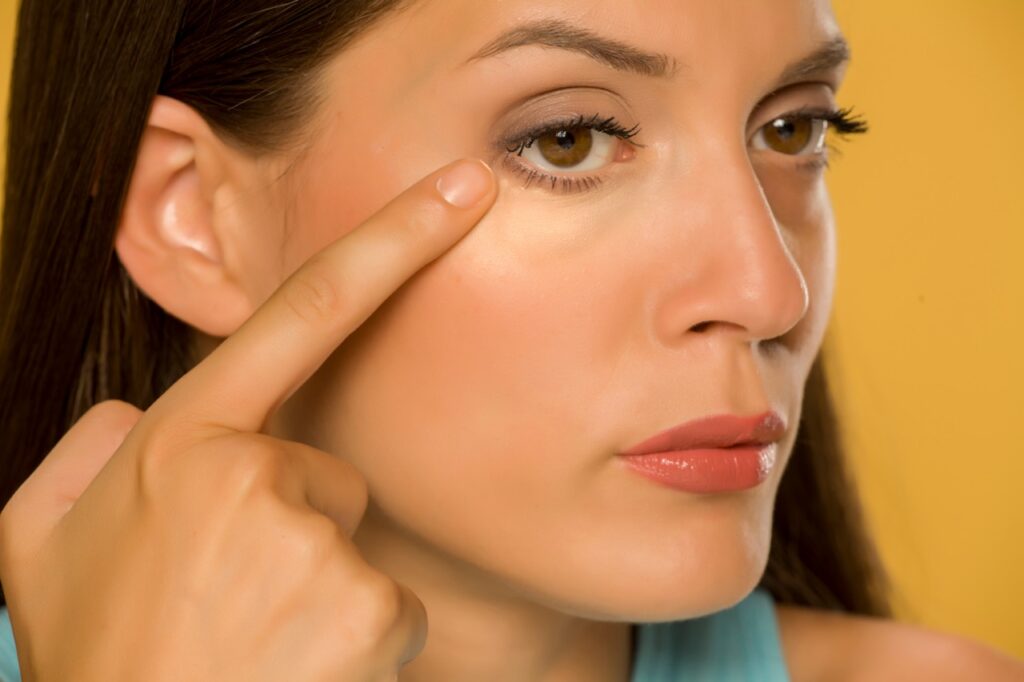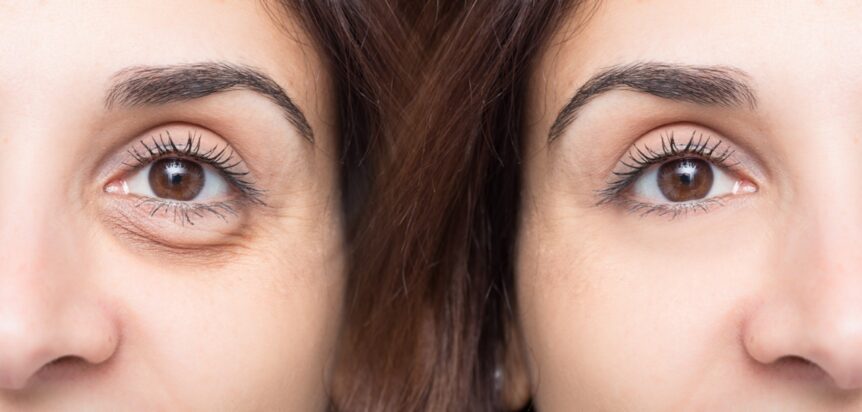Coping with Those Pesky Dark Circles under Your Eyes
We’ve all heard it and it’s a statement that quickly brings us down. Wow, you look really tired! Is everything OK?
Why is it that even on days when we’re well-rested and fresh, those annoying dark circles under our eyes somehow show up, making us look weary, old, and dull.
The next logical question: What’s causing this frustrating condition, and what can I do to make it go away?
The What and Why of Dark Circles
Dark circles and bags under the eyes are just that: the skin directly below the eyes is darkened. Depending on your natural skin color, the area in question appears as some shade of blue, purple, brown, or black. Puffy eyelids are a related occurrence and may appear in tandem with dark circles. The puffiness casts shadows that make circles look deeper and darker.
The most common causes are:
- Aging. As we age, skin below the eyes loses collagen and elasticity, loosens, and thins out, making blood vessels underneath more visible as they darken the skin. Deep creases between the lower eyelid and upper cheek called tear troughs can also form, casting shadows below the eyes.
- Genetics. For many of us, dark circles are a hereditary trait built into the familial code, as are deep-set eyes that shadow underneath.
- Fatigue. Lack of sleep due to work pressures, family issues, health conditions, stress, or any other reason, as well as poor sleeping habits, make under-eye skin appear dark and unhealthy. Blood vessels showing through the skin become more prominent and contribute to looking tired. Sleep deprivation also leads to fluid buildup under the eyes, causing puffiness and shadows, and turning skin dreary and pale.
Also watch out for the dehydration and excessive salt consumption that make eyes look dull and dilate blood vessels so they show through the skin; hyperpigmentation from too much sun exposure and subsequent increase in the melanin that gives skin its color; and lifestyle factors like smoking and excessive alcohol use. Too much time staring at computer, television, tablet, and cell phone screens is another source of eye aggravation. And don’t rub your eyes when they’re inflamed or itchy; that causes them to swell and blood vessels to break.
For some of us, medical conditions like allergies, anemia, eczema, and dermatitis also come into play. If severe, a visit to your healthcare professional can control the situation. Steadily worsening or severe darkening, puffing, swelling under just one eye, or distinctly uneven appearance from one eye to the other also warrant a professional appointment to make sure nothing more worrisome is going on.

Lifestyle Changes Can Alter Eye Appearance
Fortunately, dark circles are rarely symptomatic of a serious medical problem, despite the fact that they affect people of all ages, races, sexes, and skin types at some point in their lives. But they do make us appear tired or old or ill, and that affects mood, wellbeing, and positivity—mostly, we want them gone.
There are a number of ways to do that, but be aware that no single technique works for everyone. Plus, your solutions can change over time due to fluctuations in cause, environment, season, medical condition, and lots more. And since you can’t change your genetic code or escape the aging process, some factors are simply facts of life.
The best way to manage shadows around your eyes is to start with the basics.
- Get more sleep, at least seven hours each night, with screens turned off. Elevating your head with a wedge or extra pillows prevents fluid from collecting under the eyes while sleeping and helps with puffiness too.
- Cut down on drinking; too much alcohol causes reduced circulation. Stop smoking and using tobacco products since that speeds up the aging process.
- Reduce stress (good luck with that) and get regular exercise. Stress affects every aspect of our lives in ways we don’t even realize so manage it as best you can. Exercise helps and contributes to better sleep as well.
- Follow a healthy diet filled with fruits and vegetables and drink plenty of water. Watch sodium intake and limit sugar; salt makes your body retain water, which causes darkened skin, bags, and puffiness, while sugar leads to obesity, headaches, jitters, bloating, and possibly, diabetes.
- Use sun protection when outside, even on cloudy days. Skin around the eyes is very sensitive and reacts quickly to UV exposure by producing more of the melanin that darkens skin. Choose a sunscreen with zinc and a sun-protection factor (SPF) of 30, and wear sunglasses and a hat.
Retail Products May Help
Over-the-counter products are a very effective way of dealing with dark circles—you simply cover them up with makeup and concealers during the day and add eye creams and moisturizers to your skin care routine at night. For day wear, a concealer one shade lighter than your skin tone can help disguise undereye circles. Go a shade lighter with makeup as well.
To hydrate and smooth skin before and after makeup, look for skin care agents that contain vitamin A, vitamin C, or vitamin K. Retinol, a derivative of Vitamin A, targets skin discoloration by boosting cell turnover and is widely touted as an anti-aging substance. Vitamin C works on hyperpigmentation by promoting collagen production and hiding blood buildup. Vitamin K promotes healthy skin. Such products are a tiny sample of the thousands of items available on every store shelf and website.
But beware the miracle cures that promise to immediately remove dark circles forever—there’s no such thing. No one technique works for everyone, making dealing with undereye circles a trial-and-error proposition. You’ll want to keep experimenting with products until you find what works for you.
Home Treatments Are an Option
Looking around the house is a great way to deal with dark circles, especially since many of the remedies use things you have on hand. For example:
- Apply a cold compress to shrink dilated blood vessels, reduce swelling, and lessen the appearance of dark circles. Simply wrap ice cubes or soak a washcloth in cold water and relax for 20 minutes as you apply to the skin under your eyes.
- Soak green or black tea bags in hot water to release the caffeine and antioxidants, then chill in the refrigerator until cold. Place the tea bags over closed eyes for at least 15 minutes to stimulate blood circulation, shrink vessels, and reduce liquid buildup under the skin.
- Slice cucumbers, chill, then apply to eyes for 15 minutes. The water content reduces under-eye swelling and dark circles.
- Mix almond oil and vitamin E for a natural remedy that’s applied gently under the eyes before going to bed. Be sure to rinse with cold water when you wake up. Coconut oil massaged under each eye at room temperature for 30 seconds can tackle dark circles. Cotton balls soaked in cold milk and held under the eyes applies lactic acid to soothe darkened skin.
- Eat plenty of potassium-rich foods like bananas, beans, and leafy greens to diminish puffiness and lighten up skin.
- Do an eye massage by gently tapping around the eyes for 30 seconds to bring skin-lightening blood flow to the surface.

Medical Procedures Involve Healthcare Professionals
Removing dark circles permanently is a job for medical and skincare professionals. They’ll evaluate your situation and let you know about treatment options, including:
- Chemical peels using alpha-hydroxy acids to reduce pigmentation under the eyes.
- Laser therapy to resurface and tighten the skin.
- Injectable tissue fillers such as hyaluronic acid gel to increase volume and smooth out skin.
- Topical creams and bleaching agents like hydroquinone and Rx versions of retinols, vitamins, serums, and gels to lighten the appearance of dark circles.
- Platelet-rich plasma injections that repair skin around the eyes, speed blood vessel growth, and strengthen collagen production.
- Blepharoplasty surgery that removes excess fat and skin from the eye area.
If you decide to go this way, make sure to minimize risk by dealing with a licensed, experienced dermatologist or healthcare provider.
Above all, remember that dark circles affect almost everyone at one time or another. So, when you get one of those Gee, you look tired comments, simply smile and say, Thanks, I feel just fine!

